Is the pervasive “wine mommy” culture a simple lifestyle choice – a fashion or hobby that will come and go, like other fads of yesteryear (so long, jazzercise, we hardly knew you)? Or is it a sign of real problems that will have a long-lasting impact on the lives of mothers and their families? Recently, worries about mom wine culture have been raised in sources ranging from academic studies to op-eds in newspapers like the Washington Post to popular mommy blogs. What was, just a few years ago, a source of naughty but harmless memes and bonding for stressed-out mothers is beginning to look like a full-blown public health crisis in the making, and experts are voicing concern across the US.
Why We Talk About the “Wine Mommy”
When we’re talking about the “wine mommy” culture, we’re talking about something very specific, and something very pervasive, all at the same time. The specific part is where the “wine mommy” of the last decade or so comes from: it’s very much a creation of the internet, and that’s where it thrives.
The wine mommy comes from the world of mommy blogs, an in an interesting way, the wine mommy is a product of, and a reaction against, that world. From the very beginning, the mommy blog had a duality going on. On the one hand, mommy blogs celebrated the moms who could do it all, maintaining a perfect home and working full time, doing amazing things while juggling more than any average mom could. On the other hand, mommy blogs reveled in “realness,” like admitting to feeding the kids Poptarts for dinner, or drinking a whole bottle of wine between dinner and bedtime.
That dizzy combination of inspiration and authenticity worked like gangbusters; mommy blogs proliferated, ordinary women with a superhuman digital marketing skills became internet celebrities and cultural spokespeople, and money was there to be made. And the mommy blog – and Facebook, and Twitter, and Pinterest, and Instagram, and so on and so on – birthed a persistent little meme.
The mama of them all – the Facebook group Moms Who Need Wine – says it all. Starting in 2009, and carrying more than 600,000 followers, it’s a perfect example of wine mommy culture, sharing memes, articles, and other content about mommy’s drinking habits. There are no end of imitators, and for the most part, the whole thing seems genuinely harmless.
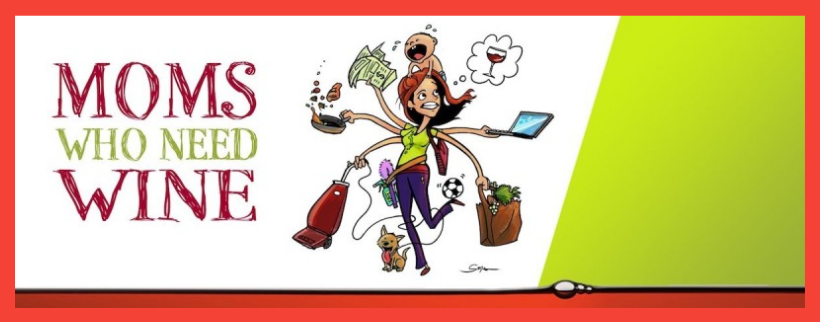
photo sourced from the MWNW FB group
Wine mommy culture is a perfect product of the internet, because it’s so easily self-perpetuating. Every meme shared, every joke (even the darkest) helps normalize and sustain the whole culture. Moms reassure each other than their drinking is normal, society is reassured that mommy’s drinking is harmless, and the train keeps rolling.
Plus, mommy wine culture is extremely marketable. That’s where the pervasiveness comes in. It may have started as a simple internet goof, but in the last decade, wine mommy culture has become a major social phenomenon, and commercialized to the edge of parody and back again (Amy Shumer’s gigantic glass of Chardonnay may be the most gleefully obvious take on the phenomenon).
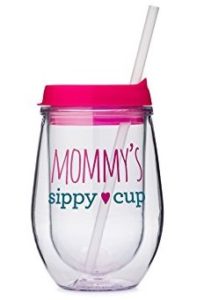
photo sourced from Amazon
Making Money Off of Wine Mommies
Even a surface search of Google or Amazon will show how widespread the wine mommy culture is, and how endlessly commodified. Wine glasses with mottos like “Mommy’s Sippy Cup” or “Mommy Fuel” printed on them; t-shirts reading “Mommy Needs a Glass of Wine”; adult coloring books, party games, even clocks with no numbers, just the phrase “Wine Time” – there is no end to the products, collectibles, knicknacks, and kitsch that have been attached to wine mommy culture, mostly to profit off dads, family members, and friends who need a gift and only know “Mom likes wine. Get her something wine-ish.”
The drinking mommy is a genre all its own on TV and in movies, too, from the breakout hit Bad Moms in 2016 (and a flood of imitators trying to capitalize on its success) to the boozy reality-show characters on every iteration of the Real Housewives. Instagram influencers for the mommy set play into it, YouTube stars get in on the action, and don’t even get started with Kathie Lee and Hoda.

photo sourced from K&H Twitter
It’s all in good fun, until it’s not. And it looks like the reckoning for wine mommy culture is here.
Why Women Drink
The wine mommy culture came at a time when Americans were reconsidering their relationship to alcohol. The craft beer movement had hit the mainstream, redefining beer drinking from something slovenly and gross (only fit for the losers who lay around Moe’s Tavern in The Simpsons) to something with class, variety, and character. Dads certainly jumped on board (but then, dads were always expected to drink).
At the same time, a boom in American wine production was making fine wines more accessible and popular. Wine has always had a different cultural connotation than beer or liquor – classy, refined, even healthy (thanks to all those news stories about wine’s antioxidants and heart health). So here was something that was refined, elegant, and beneficial, and it was more available and affordable than ever.
All that made wine way more acceptable for women than any other vice – certainly better than swilling back a beer, downing a shot, or, heaven forbid, lighting up a smoke (tobaccy or wacky). It also made it easier to hide the dark side of wine love.
One crucial aspect in understanding the public health impact of wine mommy culture is getting a clear picture of why women drink, and particularly why moms drink. Obviously, wine mommy culture isn’t making moms drink – it’s a pop-culture reflection of real, unaddressed issues in society and the lives of women. These are deep-seated, complex underlying troubles, and they can’t easily be solved; they range from professional and personal pressures to fundamental ideas about the role of women and mothers in society.
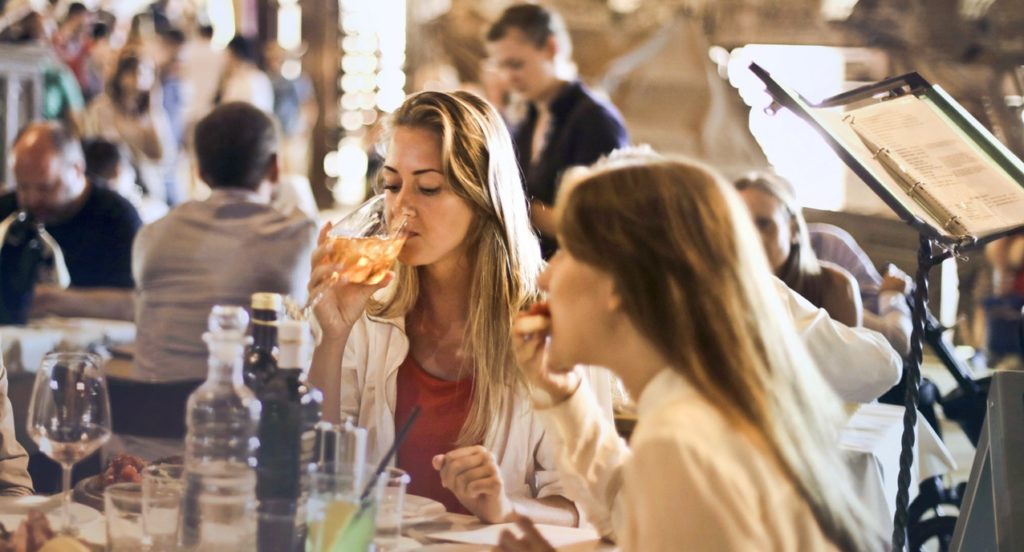
Say my name sun shines through the rain… (am I the only one hearing a Bangles song?)
Socializing: Since it was discovered, alcohol has been used as the great socializer, bringing communities together, making the shy friendly and the outcast accepted. Unfortunately, social drinking and binge drinking go hand in hand, and binge drinking is one of the main signs, and first causes, of problem drinking. However, social binge drinking often becomes a cover for alcoholism, preventing women from recognizing signs of problem drinking in themselves, or seeing it in their friends.
Many moms who develop drinking problems see their issues start with social drinking – mom’s nights out, Sunday mimosa brunches, weddings and anniversary parties, and other occasions when alcohol is expected and plentiful. It’s important to note, as the CDC does, that most women who binge drink will not become alcoholics. Only around 10% actually reach a dependence level of drinking, though some experts estimate as high as 1 in 7, due to the cultural taboo against women acknowledging and reporting their problem. Even 10%, however, indicates a significant problem for millions of women.
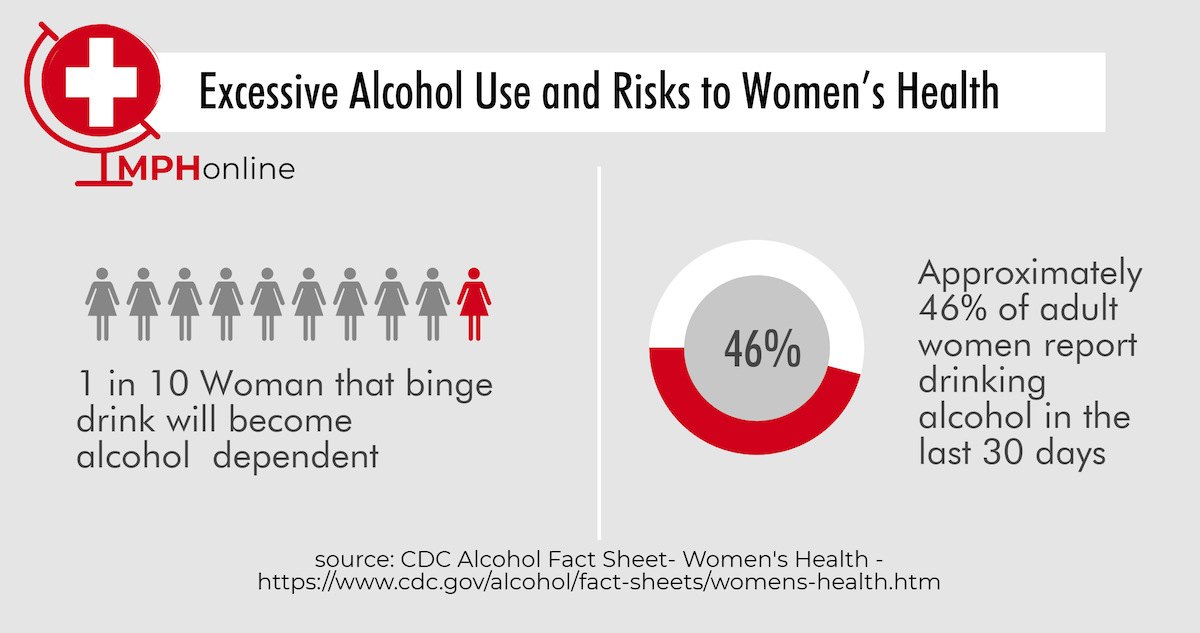
Stress Relief: The primary reason women give for drinking is to relieve stress – and of course, that is one of the primary reasons any adult drinks. But from the quack “hysteria” cures of the 19th century to the “mother’s little helper” of the mid-20th century to today’s “mommy juice,” the stress of motherhood has long been seen as a disease requiring a cure. And, in all of those examples, the cure often proves to be worse than the disease.
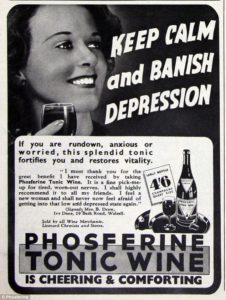
um… probably not
A harmless nightcap is deeply ingrained in American culture, but there’s a big difference between granny’s hot toddy (ask her for the recipe before it’s too late, it’s a classic) and a whole bottle of chardonnay. The popular image of the mom tucking the kids in and retreating to the kitchen for a well-deserved, relaxing glass of wine hides the very real issue of nighttime binge drinking. Many wine mommy memes make light of this phenomenon (one of the most popular, asks why “8 glasses of water a day seems impossible, but 8 glasses of wine can be done in one meal”).
Self-Medicating: Beyond simple stress relief, the drinking represented in wine mommy culture can be seen as dangerous self-medicating, especially for undiagnosed or unacknowledged emotional and psychological issues. More than 10% of women report depression; more than 8% report anxiety disorders. And those numbers, from the World Health Organization, can only include women who report their problems – not the many, many more who go unreported.
For generations, feelings of depression, anxiety, guilt, and other mental health dangers have been dismissed as just a part of motherhood. Societal bias against mental illness prevents many women from seeking safe and effective treatment, and instead leads them to self-medicate, most commonly using alcohol. Unfortunately, self-medicating only allows underlying emotional issues to fester and deepen, compounding the damage over time.
Rebellion: A lot of the appeal of the “bad mom” genre in movies, TV, and online, is the image it projects of rebellion against social pressures. It’s well understood that a lot of the stress mothers feel comes from unrealistic social expectations – the cult of the “perfect mom” and the “woman who has it all together.” The “bad mom” is the opposite reaction against that cult, celebrating the mom who is a “hot mess” and actively rebels against the cult.
Ask any young mother – the cult of perfect motherhood is real, and damaging. It perpetuates a lot of unfair and dangerous stereotypes, and generally has the effect of increasing the stress and emotional damage that leads to drinking (see above). The problem, though, is that the “bad mommy” lifestyle is not a positive, constructive response to real inequities – it’s a self-destructive one, masked as naughty, even feminist, fun.
How Wine Mommy Culture Hides a Public Health Crisis
A lot of the concern public health experts have been raising about wine mommy culture is the normalization of binge drinking. Generally, the definition of binge drinking (as set by the National Institutes of Health) is understood to be drinking behavior that causes a person to reach the legal definition of intoxicated (.08 BAC) in a very short period of time. For the average woman, that’s about 4 drinks in 2 hours. If that sounds familiar, watch out.
The numbers don’t lie – if anything, they’re too conservative. The Journal of the American Medical Association has found that between 2001 and 2013, rates of high-risk drinking (behaviors that could lead to alcoholism) were up 58% for women, and that rates of problem drinking rose more than 84%. It’s worth mentioning that those numbers come before the real height of wine mommy culture in the last 5 years. It’s almost as if internet culture is reflecting and amplifying a social trend – which is exactly what the internet is good for.
The problem is one of cultural perception, that doesn’t allow Americans to recognize problem drinking when we see it – until it’s too late. For one, we have a very misplaced idea of the “typical alcoholic,” that keeps us from seeing alcohol abuse in moms who keep their kids fed and clothed, maintain a job, serve their community, have satisfying relationships with partners and friends – all of the conventional signs of a healthy, happy life.
Many experts have commented on the power of social media to perpetuate the problem of cultural perception, as women are able to use their Facebook, Twitter, Instagram, and other social media outlets as a way to project an image of well-being that is taken for truth. Funny wine mommy memes contribute to that image – they tell friends and families “My drinking isn’t a problem, it’s just an amusing hobby.” After all, addictions don’t come with cute gifs and viral videos.
In comparison to the growing, nationwide opioid epidemic, or the dangers of meth and crack in rural communities, wine mommy culture appears benign – at most, a bit of a vice. We’re only able to perpetuate that cultural perception, though, if we ignore the long-term health dangers, and the long-term dangers to families, that come with living as a “functional alcoholic.”
Long-Term Health Damage
The idea of a “functional alcoholic” is, itself, very dangerous; it implies that “real alcoholics” are those who are dysfunctional – they’re not able to work, can’t take care of their families, end up in and out of jail, and otherwise “fail.” The “functional alcoholic” succeeds at all the key aspects of a “good life,” so they can’t really be addicts. Not being perceived as an alcoholic, though, doesn’t mean alcoholic moms don’t suffer from the long-term health damage of addiction.
Life has never been fair to women, and when it comes to drinking, there’s still a disparity. More men report having a problem with alcohol, but women are more prone to developing alcoholism from the same behaviors. Because of the composition of women’s bodies, women get drunk faster, process alcohol out more slowly, and become dependent more easily than men. That’s why, when experts define moderate alcohol use, one glass of wine is moderate for women.
At the same time, alcoholic women are far more likely to suffer health damage than alcoholic men. Alcoholic moms are much more likely to develop brain damage, liver damage, and heart disease than alcoholic men. And women who have a drinking problem are much more likely to experience hormonal problems, cancer, and even osteoporosis than women who drink moderately.
Dangers to Family
The dangers of alcoholism aren’t just confined to the alcoholic mom, though, of course – it’s also a serious threat to family life. Alcoholism, like other mental illnesses and addictive behaviors, tend to run in families, both because of possible genetic factors that increase a risk of addiction, and because of behaviors that children learn from parents. It’s the classic nature and nurture problem. Addictive behaviors are, in part, genetically linked, but when children see an alcoholic mom self-medicate, or learn to dismiss alcohol abuse as harmless, they are more likely to follow their parent into addiction.
Growing up with an alcoholic mother is a major risk factor for future alcoholism. A report from the Substance Abuse and Mental Health Services Administration (SAMHSA) finds that as much as 10% of children in America live in a home where at least one parent has a drinking problem. Having just one alcoholic parent increases children’s risk of abuse, accidental injury, and, of course, becoming an alcoholic themselves in adulthood. To put it simply, growing up with an alcoholic mother is dangerous – even if she’s put together on the outside.
The dangers posed to family members are especially increased because women are much less likely than men to seek help for their addiction. On one hand, there is the built-in social bias that makes us blind to alcoholism in women – what we call wine mommy culture. On the other hand is the social taboo against addiction in women, which makes women afraid to seek help even when they realize they have a problem. Women fear losing their spouse or partner, having their children taken away, and being ostracized for their weakness and failure. That means more children growing up with an alcoholic mother than ever – a public health danger that can continue to reverberate through generations.
What Can We Do About Wine Mommy Culture?
It would be easy to dismiss worries about wine mommy culture as “concern trolling” or fear-mongering if it weren’t backed up by so many experts and so many trusted agencies. The Centers for Disease Control, after all, aren’t known for overreacting. So if there really is an emerging public health danger, what can we do about wine mommy culture?
Awareness is primary. Alcoholics Anonymous has its fair share of skeptics as well as its true believers, but no one has ever laid it out quite as clearly and concisely as the first of their 12 Steps: admit you have a problem.
In just the last year or so, America has been collectively taking a deep breath and admitting it has a problem. Op-eds in sources like the New York Times and the New York Post have taken the wine mommy culture to task, forcing us to give some thought to why “Mommy Juice” should be funny in the first place. Wine mommy culture is getting pushback in the mommy blogs too, from the very place where it first started, with articles like “Why I’m Done Making Mommy Wine Jokes” making the rounds on popular sites like Scary Mommy.
In other words, the mommy blogs are seeing the baby they birthed, and realizing it might just be a monster. And, just like they always have, the mommy blogs are telling it like it is, and reaching moms in a way that even their friends and family can’t.
Finding Help for Yourself and Your Family
Family members should be alert and aware, and this is often difficult; problem drinking is usually very well hidden, until it becomes a crisis, and many of the issues that drive women to drink are family related – such as being too busy, feeling unnoticed, and struggling to cope emotionally with family responsibilities. A healthy family and friends network is crucial to recognizing a drinking problem before it becomes a full-blown addiction, and for helping a person overcome an addiction.
If you think you may be an alcoholic, or are developing a drinking problem, there are resources out there for help. The SAMHSA Help Line is available to call all day, every day for advice and treatment recommendations; Alcoholics Anonymous chapters are widespread, and in an urban or suburban area, there’s very likely a meeting any time of day.
Overcoming the shame and bias that American culture has created against women with addictions is not easy to do, but if you’re a mom with a drinking problem, you’re not just doing it for you – you’re doing it for the little ones watching you. They’re not really the ones making you drink, but they could be the ones who make you stop.
Resources:
CDC Fact Sheet, Excessive Alcohol Use and Risks to Women’s Health
Narconon, How to Help an Alcoholic Family Member
SAMHSA Help Line